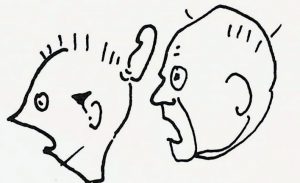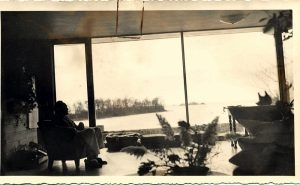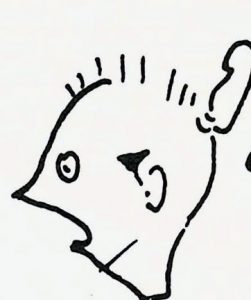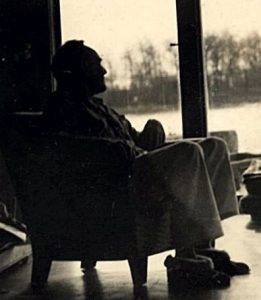
Dear P-Js We’ll be seeing you in ’65 surely. HW
38 Dock Road, South Norwalk, Conn.
WE ARE SCARED!
Just as we were beginning to believe our grandchildren might live to grow up, along comes Goldwater! He doesn't go for test bans. But a lot of people go for him; practical, energetic young folk who long to believe Americans can do no wrong; should get all they can and keep all they get; that Communism is the root of all evil. Freedom (free enterprise) is their birthright ….. What a simple and inviting world Goldwater presents, the world of his pedlar grandfather, and presents it well because he believes in it. He even thinks he can – get it with nuclear weapons.Bandwagon politicians cheer! But we do want our babies to grow up. We must obliterate Barry and his bandwagons, not by an inch, but an avalanche; bury for good his obsolete wish-dreams, and get on with the real problems of a real world. This takes votes for Johnson; our votes, your votes, absentee votes, every vote we can all of us muster. Keep itching fingers away from nuclear push buttons! HELP! Anita Willcox Henry Willcox

“We are scared” by Anita and Henry Willcox is a political flyer in the Park J. White Papers at the Bernard Becker Medical Library. It caught my attention, because I was a child in 1964 and highly interested in the Goldwater- Johnson presidential campaign. I like the flyer’s cartoons, political humor, and good graphic design."We are scared" and its companion piece, a letter from Henry Willcox to Park J. White are primary sources.
A recent book on the historiography of nursing history in our library, Lewenson & Hermann's Capturing Nursing History, 2007, has this to say about primary sources:
Historical studies need primary sources. These sources provide firsthand accounts that can offer the historian important insight into a particular period, event, or person’s life. Primary sources supply evidence to past experiences. Yet, the primary sources, such as letters, diaries, and minutes of meetings, lack critical analysis and often contain the bias of the original author of those sources. The historical researcher must critically analyze the primary sources used in their study (Lewenson & Hermann, 2007, page 34).
To critically analyze primary sources, Historians use secondary sources for context. Lewenson and Hermann have this to say about secondary sources:
Secondary sources provide depth and meaning to a topic. They inform the researchers’ understanding of what has been written before about the subject. One source can provide the names of other sources that can and perhaps should be reviewed.
For context, I looked at the lives of Henry and Anita Willcox to find some clues as to what these documents are saying. A transcript of Henry Willcox' letter to Park J. White, short biographical sketches of the creators of these documents. and a summary of my conclusions follow.
A companion letter from Henry Willcox in the Park J. White Papers
Box 487, Sou. Norwalk, Conn. 11-20
Dear Park,
Have been holding back my reply to wait for a picture of our new exclusive Willcox & [illegible] (healing to a light breeze). If this camera wasn’t so near-sighted, you’d have Long Island in the background – My last X-ray was rated “beautiful’ by Dr. Muschenheim but my exterior aspect was better after stage 1 than stage 2. – In 2 more weeks, I get 15 minutes’ exercise, which will take me to the three little houses Roger, Sally, Ann – and spouses are building – Meantime, Nita & I are doing all right.
Your tale of the holdup is fantastic. I admire your spunk to grab the man, but thank God he didn’t shoot! Gratifying to catch him. Still wonder if you were reimbursed. And I love your thanking him for not shooting, if he proved to be the guy. I’m going to send your tale on to Phyllis.
What I was going to say (when supper intervened,) I think I agree entirely with your sentiments on current medical service, tho “the young M.D. on the assembly belt” presumably could gain respite by country practice, if he felt he could make a living at it… Is Sinclair Lewis’ “Main Street” just fable? — Young engineers are currently trying to form a union, which W.C. Co. is prepared to recognize. Would that be a solution for interns?
Best as ever
H.W.
Anita Parkhurst Willcox, 1892- 1984
Anita Parkhurst Willcox was a painter and illustrator (Fielding [1926]). She was 72 when she drew the cartoons for We are scared (Willcox 1964). Henry Willcox, her husband and collaborator, was 74 when he sent the anti-Goldwater leaflet to the Park J. Whites in 1964, a year after the nuclear test ban treaty in 1963. The sketch below is largely a summary of the illustrated article on her in Wikipedia, which features many examples of her art.
She was born Anita Parkhurst in Chicago (Fielding [1926]) on November 11, 1892 (American Art Annual : Biographical Directory: American Artists 1930) and attended Hyde Park High School. She studied at the Art Institute of Chicago (Fielding [1926]) (American Art Annual : Biographical Directory: American Artists 1930) from 1909 to 1913 (Art Institute of Chicago 1913-1914). At the Art Institute she learned classical drawing and also studied mural painting with John W. Norton. As a student, she drew illustrations of hats for Gages, the largest millinery company in the country.
She moved to New York where she worked as a graphic artist and commercial illustrator and she initially shared a studio with Neysa McMein. In New York, he joined a social and intellectual group that became the Algonquin Round Table in 1919. She was a member into the 1920s and she also was a member of the Free Lance Artists and the Society of Illustrators.
She married engineer Henry Willcox in 1918. While Captain Willcox served in the in the First World War, Anita went to France with the YMCA. Initially, she worked at a canteen for the First Division Army at the Second Battle of the Somme of 1918. Later her studio partner Neysa McKein, Anita, and Jane Bullard developed and performed a vaudeville show for troops on the front lines. Her war experiences changed her and after that point she was anti-war.
After the war, she and Neysa McKein and and Ethel Rundquist illustrated Entertaining the American army: the American stage and lyceum in the world war (Evans 1921). She returned to married life with Henry and she resumed her commercial art career (Anita Parkhurst Willcox n.d.). Her art was signed throughout this period as Anita Parkhurst. Her commercial graphics from 1913 to 1929 included covers for Saturday Evening Post, Colliers, Every Week, Fashion Art and Screenland.
By 1930, “she had given birth to four children and adopted a fifth and concluded that the images she was creating were not an accurate reflection of women’s lives.” Peter Willcox of Greenpeace is the oldest of she and Henry's grandchildren. She quit commercial illustration work in 1930, arguing that these images were “socially pernicious.” In the Depression, she did art work outside commercial art including graphics and posters for The Masses and for the Norman Thomas' League for Industrial Democracy. later campaigns denouncing the Korean War and nuclear weapons.
Henry Willcox (H.W.), 1890-1973
Henry Willcox was born in Staten Island, New York. He graduated from Harvard University in 1913 with distinction in mechanical engineering. So he was one year behind of Park J. White who graduated from Harvard in 1912. He was a member of Phi Beta Kappa.
In 1912, he designed and built a reinforced concrete coal pocket with a 500 ton capacity and he designed and tested concrete machinery at the plant of the Ransom Concrete Machinery Co., Dunellen, N.J. In 1914 he served as draftsman and timekeeper for the Turner Construction Co., New York, NY. From 1916 to 1918, he was employed as construction engineer by Kalmus, Comstock & Westcott, Inc., Boston, MA. He built a $150,000 addition to an electric furnace plant in the Niagara district. Henry Willcox served as a construction engineer in World War I.In 1920, Henry was a junior member of the American Society of Civil Engineers and a construction engineer. (WW Const. div. [c. 1920]).
In 1950 the Willcoxes and their three of their children founded Village Creek, a Community in Norwalk Connecticut. It became the first inter-racial cooperative on the Eastern seaboard. It is today 60 houses and a national Historical Monument (Anita Parkhurst Willcox n.d.). Henry in the letter talks of “three little houses, Roger, Sally, Ann and spouses are building.” (Park J. White Papers, Bernard Becker Medical Library Archives, Washington University School of Medicine. 2015)
In 1950 Henry was still president and chief engineer of his own firm. Willcox Construction Company was the biggest public housing contractor in New York City (Greenpeaces's Peter Willcox captained the ill-fated Rainbow Warrior 2013). This is the W.C Co. he refers to in his letter of November 20.
Anita and Henry Willcox represented the Quakers at the Asia and Pacific Rim Peace Conference in Peking, 1952. Anita sketched participants at the peace conference and they travelled throughout Red China afterward ("Anita Parkhurst Willcox" Wikipedia, n.d.). In China, Henry, according to Peter Willcox, "saw evidence of the U.S. use of chemical weapons during the Korean War. And Talking about that cost him his company, cost him his fortune, caused him to take a retirement in his early fifties, absolutely changed his life. Our passports were taken, and it took us I think about eight years, pushing a lawsuit all the way to the supreme court to get them back… It took a lawsuit all the way to the supreme court to reaffim American's rights to travel. " (Greenpeaces's Peter Willcox captained the ill-fated Rainbow Warrior 2013).
Anita Willcox was a target for McCarthy era censorship and at age 70 was called to testify by the Eastland Committee for attending the Peace Conference and because she funded the legal defence of Harvey Matusow. Publicity meant she was unable to find a publisher for a book on India where she attended another peace conference in 1949, the Norwalk (local) elementary school would not take her murals depicting Norwalk Harbor in the 17th century and her Husband Henry Willcox was expelled from the Willcox Construction company ("Anita Parkhurst Willcox" Wikipedia, n.d.)
Context
History teachers and professors often give writing assignments to students where the student picks an primary source and provide context for it in a paper. Students then write a short article about the item providing context.
However the lack of obvious dates are a problem with both the anti-Goldwater flyer and the letter. Fortunately, there is internal evidence of the date of the flyer on pages 2 and 4. Page 4 has an article from The Nation from August 24, 1964 and on page 2 has an excerpt from Liberation also dated August 1964. Excerpts from The Conscience of a Conservative, a book written by Barry Goldwater in 1960 are also on pages 2-4.
My first guess on the date of the illustrated flyer was 1964, because I remember the Presidential campaign of 1964 for its attack ads. I will never forget the "Peace Little Girl (Daisy)," a anti-Gold water commercial by by the Lyndon Johnson campaign. There were no superpacs in those days; commercial were put out the political parties. The candidates, Lyndon Johnson and Barry Goldwater, a liberal and conservative were far apart on the issues of the day. The candidates were a real contrast and they fought a bitter campaign. This flyer is tame in comparison the the Lyndon Johnson commercials. The commercials for both sides of the 1964 campaign at the Museum of the Moving Image Website are available on their website and are also original sources.
The letter from Henry Willcox was more puzzling as to date. I thought at first it was written near the end of his life because of the references to stage 1 and 2 of cancer. But then I saw H.W.'s comments about the holdup that happened to Park J. White. One folder in the Park J. White papers documents a holdup of White and his partner, George Sato, in December 1950 (Montgomery, James L. 1950-1964) . So the letter may be closer to 1950, maybe November 10, 1951. It was 1952 when the state department confiscated the couple’s passports, and sometime after that when Willcox lost his firm, the W.C. Co (Willcox Construction Company?) he refers to in the third paragraph.
The Park J. White Papers is a large collection of primary sources and there are many collections in our archives. Check out our archives database for others. Digitized documents are posted in our digital commons and image gallery.
Bibliography
American Art Annual : Biographical Directory: American Artists. Washington: American Federation of the Arts, 1930.
"Anita Parkhurst Willcox [by Guin Thompson]." Women in Illustration. 2010? http://womeninillustration.tumblr.com/post/97751785062/anita-parkhurst-willcox (accessed August 2015, 31).
"Anita Parkhurst Willcox." Wikipedia, the free encylopedia. n.d. https://en.wikipedia.org/wiki/Anita_Parkhurst_Willcox (accessed August 31, 2015).
Annual of advertising art in the United States 1921: a catalogue for the first annual exhibition of advertising paintings and drawings held by the art directors club at the galleries of the national arts club New York, from March 2 to 31. New York: Published for the Art Directors club by Publishers Printing Company, 1921.
Art Institute of Chicago. Report for the year 1912-1913, 1913-1914. Chicago: The Institute, 1913-1914.
Art Institute of Chicago. Bulletin of the Art Institute of Chicago. July 1909: 11.
Evans, James W. and Gardner L. Harding. Entertaining the American army : the American stage and lyceum in the world war / James W. Evans and Gardner L. Harding ; with illustrations by Neysa McMein; Anita Parkhurst and Ethel Rundquist. New York: Association Press, 1921.
Fielding, Mantle. Dictionary of American Painters, Sculptors and Engravers. Philadelphia : Printed for the Subscribers, [1926].
Lewenson, Sandra B., and Herrmann, Eleanor Krohn. Capturing Nursing History : A Guide to Historical Methods in Research. New York, NY, USA: Springer Publishing Company, 2007. ProQuest ebrary. Web. 5 October 2015.
Montgomery, James L. 1950-1954. (Robbery of Dr. White and Dr. Sato’s offices). Box 6, Folder 4, Park White Papers, Bernard Becker Medical Library Archives, Washington University School of Medicine.
Audio recording, "Greenpeaces's Peter Willcox captained the ill-fated Rainbow Warrior." Conversations with Richard Fidler. April 4, 2013. http://www.abc.net.au/local/stories/2013/04/04/3729758.htm (accessed September 28, 2015).
Museum of the Moving Image. The Living room Candidate, Presidential Campaign commercials 1952-2012, 1964 Johnson vs Goldwater. 2012. http://www.livingroomcandidate.org/commercials/1964 (accessed September 28, 2015).
"Nuclear test ban treaty." John F. Kennedy Presidential Library and Museum, Columbia Point, boston MA 02125. n.d. http://www.jfklibrary.org/JFK/JFK-in-History/Nuclear-Test-Ban-Treaty.aspx (accessed September 28, 2015).
"Peter Willcox." Wikipedia, the free encyclopedia. September 8, 2015. https://en.wikipedia.org/w/index.php?title=Peter_Willcox&oldid=680053522 (accessed September 28, 2015).
White, Park J. "Curriculum vitae." 1970.
Who's Who in the Construction Division of the United States Army. New York: Simmons-Boardman, [c. 1920].
Willcox, Anita and Henry. "We are scared," [1964], Box 7, Folder 27, Park White Papers, Bernard Becker Medical Library Archives, Washington University School of Medicine.
[Willcox, Henry] H.W. to Park J. White, Nov. 10 [1951]. Box 7, Folder 32, Park White Papers, Bernard Becker Medical Library Archives, Washington University School of Medicine.


